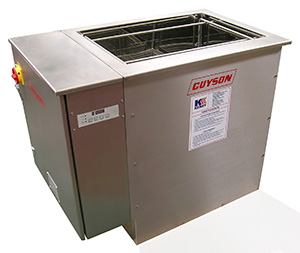Guyson joins BLOODHOUND SSC land speed project

Leading industrial finishing equipment manufacturer Guyson International is proud to announce that it has recently become a product sponsor of the great engineering adventure called BLOODHOUND SSC, which has as its ultimate goal to achieve the record speed of 1000 mph on land.
A significant element in undertaking this great engineering challenge has also been the objective of becoming the catalyst to inspire the best of British engineering to get involved with the project as well as to enthuse the next generation of schoolchildren to get involved in engineering. Over 250 UK companies, 180 of them SMEs, are involved in the Project, which has become a showcase for UK science and engineering capability. Additionally over 6000 UK primary and secondary schools have signed up to use the free BLOODHOUND Education resources in their classrooms.
Guyson will be donating one of its premier industrial quality Euroblast 6SF blast cabinets, including a C400 dust collector equipped with explosion relief and vertical ducting, for use in the group’s workshop for the preparation of titanium, aluminium and composite parts prior to bonding. The cabinet is specially fitted with cut outs on both sides of the cabinet, to allow longer two and a half metre titanium pieces to be blasted periodically in the same cabinet. The cut outs allow the longer pieces to be passed through the cabinet for blasting and blanking plates are fitted over the side cut outs when the machine is used as a normal blast cabinet.
Additionally, for all-purpose precision cleaning of components, the project will use a Guyson KS1500 ultrasonic cleaning tank. This 316L polished stainless steel tank has an effective working capacity of 117 litres, with internal tank dimensions of 450mm breadth by 650mm wide. Guyson’s ‘Kerry’ branded ultrasonic tanks have been designed to achieve optimum cleaning results using aqueous solutions. Ultrasonic transducers bonded to the tank base provide high performance and reliability together with uniform distribution of the ultrasonic energy. The frequency is factory tuned to the individual tank/transducer combination and then optimised under normal usage conditions with frequency sweep and fully automatic tuning to deliver a robust ultrasonic cleaning performance.

The BLOODHOUND SSC project first got off the ground way back on October 28th 2008 at the Science Museum in London when Richard Noble, Andy Green and the team announced to the world their latest plan to smash the World Land Speed Record, and at the same time inspire the next generation of Scientists and Engineers with this iconic project. The present world land speed record is 763 mph held by Thrust SSC, a UK team lead by BLOODHOUND’s Project Director Richard Noble and driven by Andy Green
Various stages have been gone through, from the basic design of the vehicle and bringing together the team to then build it. The vehicle being named BLOODHOUND SSC after Ron Ayers’ first missile, the Bristol Bloodhound 2 - an incredible surface-to-air missile that could accelerate from standstill to Mach 1 in 2.5 seconds. And BLOODHOUND is no lightweight, weighing in at 7½ tons, and is 44 feet long by 6 feet wide, powered by three engines: a Rolls-Royce EJ200 jet from a Eurofighter Typhoon, a cluster of NAMMO hybrid rockets and a 650 bhp racecar engine that drives the rocket oxidiser pump. Between them they generate 135,000 equivalent hp, equal to 180 F1 cars. And at full speed BLOODHOUND SSC will cover a mile in 3.6 seconds, that’s 4.5 football pitches laid end to end per second.
BLOODHOUND SSC is currently being assembled at the BLOODHOUND Technical Centre in Bristol. It is on schedule for roll out summer 2015 where it will undergo UK runway testing up to 200 mph (321 kmh) at the Aerohub, Newquay. The Team will then deploy to South Africa to begin high speed testing with the target of reaching 800 mph (1,287 kmh).
The BLOODHOUND team has scoured the globe to find the perfect desert to run the car on, as it needed to be at least 12 miles long, two miles wide and perfectly flat. They hopefully have found it in a vast, dried-up lake bed called the Hakskeen Pan, located in the Kalahari desert in South Africa’s Northern Cape.
Once preliminary runs have been undertaken, it is planned that the Team will then return to the UK to review the data and return to South Africa in 2016 with the aim of reaching 1,000 mph (1,609 kmh) - faster than a bullet fired from a .357 revolver!



